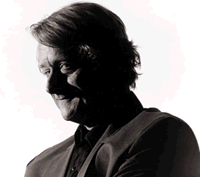Ted
Nelson is a somewhat controversial figure in the computing world.
For thirty-something years he has been having grand ideas but has
 never
seen them through to completed projects. His biggest project, Xanadu,
was to be a world-wide electronic publishing system that would have
created a sort universal libary for the people.He is known for coining
the term "hypertext." He is also seen as something of a
radical figure, opposing authority and tradition. He has been called
"one of the most influential contrarians in the history of the
information age." (Edwards,
1997). He often repeats his four maxims by which he leads his
life: "most people are fools, most authority is malignant, God
does not exist, and everything is wrong." (Wolf,
1995)
never
seen them through to completed projects. His biggest project, Xanadu,
was to be a world-wide electronic publishing system that would have
created a sort universal libary for the people.He is known for coining
the term "hypertext." He is also seen as something of a
radical figure, opposing authority and tradition. He has been called
"one of the most influential contrarians in the history of the
information age." (Edwards,
1997). He often repeats his four maxims by which he leads his
life: "most people are fools, most authority is malignant, God
does not exist, and everything is wrong." (Wolf,
1995)
Beginnings
Nelson
was raised by his grandparents in Greenwich Village, New York. His
father is a movie director and his mother an actor. He had little
contact with his father and almost none with his mother. He was lonely
as a child and had problems caused by his Attention Deficit Disorder
(ADD).
Nelson
attended Swarthmore college where he earned a BA in philosophy. In
1960, he enrolled in graduate school at Harvard. During his first
year he attempted a term project creating a writing system  similar
to a word processor, but that would allow different versions and documents
to be linked together nonlinearly, by association. This was, in part,
an attempt to keep track of his own sometimes frantic associations
and daydreamings brought about by his ADD.
similar
to a word processor, but that would allow different versions and documents
to be linked together nonlinearly, by association. This was, in part,
an attempt to keep track of his own sometimes frantic associations
and daydreamings brought about by his ADD.
Nelson
did not complete the project, but he continued to work on it after
that semester and it became the overriding concern of his life. In
1965, he presented a paper at the Association for Computing Machineryin
which he coined the term hypertext. Nelson's system was very similar
to that envisioned by Vannevar Bush.
Xanadu
Nelson
continued to expound his ideas, but he did not possess the  technical
knowledge to tell others how his ideas could be implemented, and so
many people simply ignored him (and have ever since). Still, Nelson
persisted. In 1967, he named his system XANADU,
and with the help of interested, mainly younger, computer hacks continued
to develop it.
technical
knowledge to tell others how his ideas could be implemented, and so
many people simply ignored him (and have ever since). Still, Nelson
persisted. In 1967, he named his system XANADU,
and with the help of interested, mainly younger, computer hacks continued
to develop it.
Xanadu
was concieved as a tool to preserve and increase humanity's literature
and art. Xanadu would consist of a world-wide network that would allow
information to be stored not as separate files but as connected literature.
Documents would remain accessible indefinitely. Users could create
virtual copies of any document. Instead of having copyrighted materials,
the owners of the documents would be automatically paid via electronic
means a micropayment for the virtual copying of their documents.
Xanadu
has never been totally completed and is far from being implemented.
In many ways Tim Berners-Lee's World Wide Web
is a similar, though much less grand, system. In 1999, the Xanadu
code was made open source.
For
Further Reading

Hyper/Text/Theory
Hypertext
2.0: The Convergence of Contemporary Critical Theory and Technology
(Parallax - Re-Visions of Culture and Society)
Home|
Vannevar Bush | J.C.R.
Licklider | Larry Roberts | Paul
Baran |
Bob Metcalfe |
Doug Engelbart | Vint Cerf | Ted
Nelson | Tim Berners-Lee |
Marc Andreesen | Epilogue |
References |